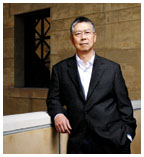
|
November 21, 2007: A moment with...
(Photo by Peter Stember) |
Gordon Chang ’70
When Gordon Chang ’70 arrived at Princeton in 1966, he was one of six students of Asian ancestry in a class of 800. Asian-American studies didn’t yet exist as an academic discipline. Even the term “Asian-American” hadn’t been coined. Forty years later Asian-American studies is a thriving discipline, and Chang, a professor of American history at Stanford University, is one of its senior scholars. Chang recently spoke with PAW contributor E.B. Boyd ’89.
When U.S. history textbooks cover Asian-American history, they typically include events like the building of the transcontinental railroad and the internment of Japanese-Americans during World War II, but little else. What are these textbooks leaving out?
The history of discrimination and marginalization of Asian-Americans should take up a larger part of the American narrative. The numbers of people of Asian ancestry coming to America have not been comparable to, say, immigration from Europe. But the energy devoted to Asian exclusion has been an important part of American popular culture, with all sorts of “yellow peril” literature, film, cartoons, and songs.
It’s also important if you want to understand the development of American immigration law, practice, and policy. The creation of the Immigration and Naturalization Service was founded on the exclusion of Chinese. The Chinese Exclusion Act of 1882 culminated decades of anti-Chinese agitation on the West Coast and other parts of the country, which found Chinese undesirable as immigrants and unwanted as part of American citizenry.
That sounds a lot like the immigration debates going on today.
Absolutely. I teach a class called “Introduction to Asian-American History,” and the students are just wide-eyed. They say, “The stuff you’re talking about from 100 years ago sounds just like today”— how certain immigrants are characterized as undesirable, racialized, marginalized, abused, misused — but also wanted for labor.
Have Asian-Americans gotten the short end of the stick in college admissions? Some research suggests that more would be admitted to universities if affirmative action did not exist.
The position of Asian-Americans in the affirmative-action debate is controversial. When affirmative action began in the 1970s, Asian-Americans were included as “target minorities.” Later, Asian-Americans were generally removed from that category, and Asian-American admissions [still] have increased.
Universities have made, on the whole, a credible and admirable effort to become much broader and more diverse in a relatively short period of time ... I think it’s to the credit of the institutions that they’ve tried to do this in the face of widespread hostility to diversity issues.
Has the rise of China been influencing Asian-American studies?
Yes, it has — in good ways and not-so-good ways. There’s an increase in people taking Chinese language, and that wouldn’t have happened without the rise of China. It’s given Chinese-Americans and other Asian-Americans all sorts of opportunities in all sorts of ways. But there’s also something that’s worrisome, and that’s an acute sense of competition and anxiety in America about China and its rise to power. There are all sorts of books now with sensational titles like “The Coming War with China.” And certainly, the issue of international tensions, challenges, and conflict is a real one. But what history shows is that you can easily become very emotional and racialize. And that’s what I fear.
Is the stereotype of Asian-Americans being extremely successful — the “model minority” — an accurate one?
Asian-Americans’ success is, in part, explained by the shape of our immigration laws, which have admitted privileged classes. The recent immigration has been from professional, intellectual, and middle classes. So the success of Asian-Americans is very much attributed to the fact that they come from successful backgrounds to begin with.
The image of Asian-Americans being quiet and submissive is a misconception, although understandable, given the marginalization of Asians in American life. But as a historian, it was interesting to go back and, if you look at the 19th century, even up until World War II, Asians were considered to be the more obstreperous and difficult group in American life.
In recent times, Asian-Americans have been viewed, particularly in schools,
as more quiet. Some of this comes from the fact that so many students
come from immigrant families. They tend to exhibit traditional behavior,
which is heavily influenced by Confucian notions of hierarchy and respect
for elders and educators. A high premium is placed on public decorum,
reserved personal behavior, inconspicuousness, and being seen as a representative
of the family — all things that lead some to think of Asians as
being quiet or less offensive. As time goes on, you’ll see those
things drop away, as they become just like other Americans. ![]()

